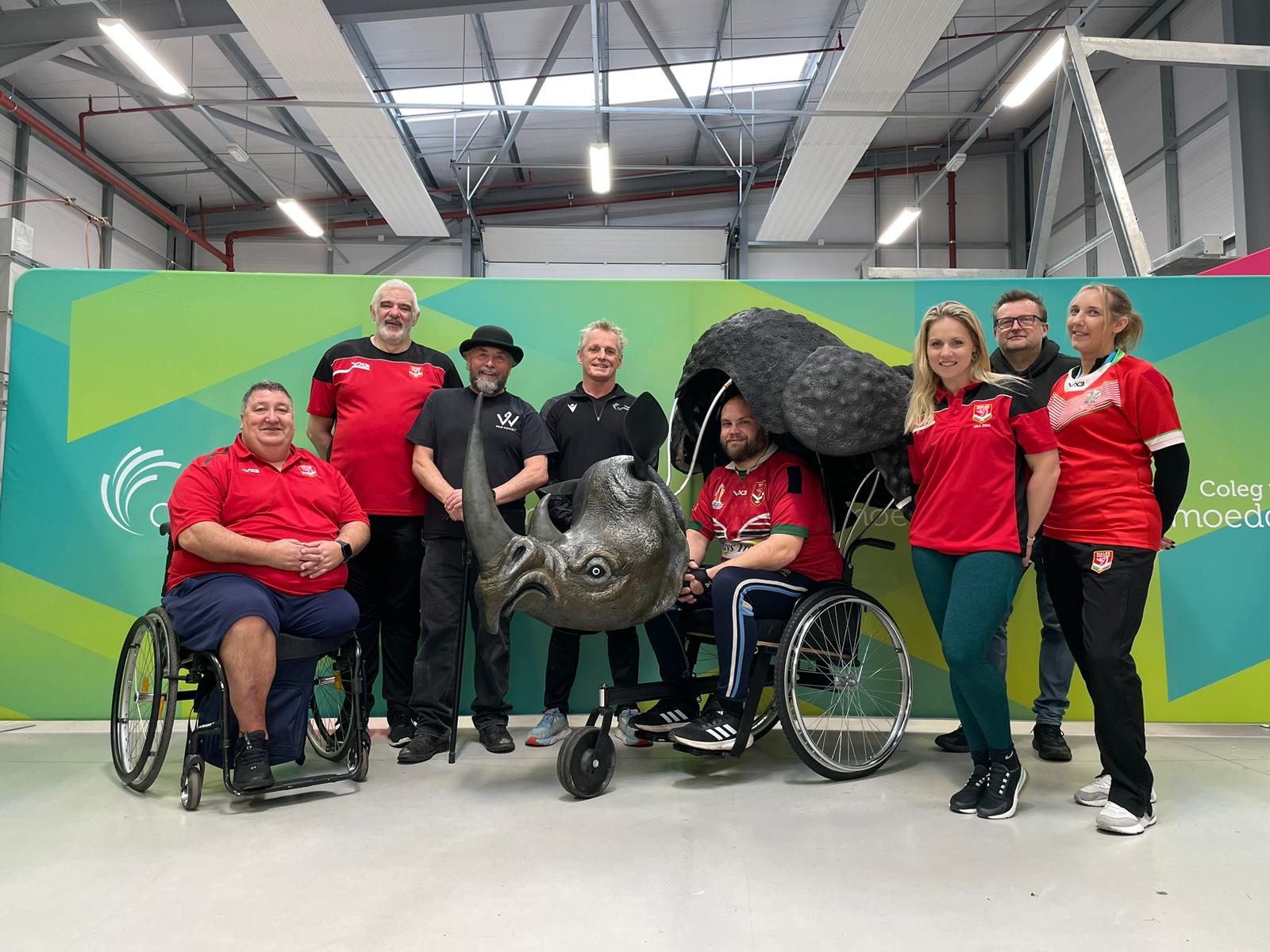Pic: Gary Taylor (Wales Wheelchair RL assistant coach), Stephen Jones (head of Wheelchair RL in Wales), William Todd-Jones (Movie Industry Legend), Mark Jones (General Manager, WRL, plus Course Leader for Rugby League at Coleg y Cymoedd), Martin Turner (North Wales Crusaders Wheelchair RL – in the chair), Sammie Hann (WRL Wheelchair Strength and Conditioning), Alistair Aston (Course Leader in the BA in Prop Making for TV and Film at Coleg y Cymoedd), Alana Sargent (WRL Wheelchair Head of Strength and Conditioning).
Spectators at this year’s London Marathon on 21 April will witness a historic moment as the first-ever rhino costume wheelchair charges through the streets of London.
The bespoke wheelchair-adapted costume has been designed by William Todd-Jones, who in the film industry is a legend behind the scenes, especially as a puppeteer on film series like Harry Potter, the Muppets, and he was involved in the design and development of the Batman costume in Tim Burton’s 1989 film.
In 1992, he was the first person to take on London’s famous 26.2-mile route whilst donning a rhino costume he had helped create for the theatre. Now, 32 years on, his creation will be worn by Martin Turner, from the North Wales Crusaders wheelchair side, who performed well in the WRL Wheelchair Invitational League last year. He will be supported by a number of his colleagues from Wales Rugby League (pictured).
The unique wheelchair costume has been constructed by students and teachers at Coleg y Cymoedd, the college that hosts the WRL National Development Academy, but now the partnership has spread to other departments for this unique charity event. The wheelchair used within the costume used produced by Motivation, an international development charity and social enterprise with a thirty-year history of wheelchair provision.
This collaborative process enabled the development of a distinctive chair-adapted costume that meets the challenges of the marathon course, whilst prioritising safety and accessibility for Martin and other participants.
Turner commented: “I’m nervous, of course, but also really excited by the challenge and grateful to have the chance to promote accessibility in sport through such a unique and iconic endeavour.”
Todd-Jones added: “Connecting people with nature is critical if we are to effectively support our planet. Bringing people together to make this unique project happen has been incredible, and I’m very proud of the fusion between culture and conservation – my two passions – that this represents.”
Coleg y Cymoedd’s Karen Workman, Vice Principal and Chief Operating Officer, said: “It has been an honour to join forces with Save the Rhino, bringing new life to their iconic costumes. Members of our Creative Industries, Engineering, Construction and Apprenticeship departments have collaborated on their restoration in our workshops and have had a great time doing so. We’re thrilled to have played such a small, but vital part in spreading Save the Rhino’s message, inspiring action for conservation.”
The origins of Save the Rhino’s iconic costumes trace back to 1989, when they were designed by Gerald Scarfe for a musical named Born Again, directed by Sir Peter Hall (founder of the Royal Shakespeare Company) at the Chichester Festival Theatre.
Over the years, following the 1992 London Marathon, the costume evolved, with additional costumes joining the ranks, culminating in this year’s total herd of 19. Alongside Martin, there will be 15 members of Save the Rhino’s team participating in the London Marathon in rhino costume.
This pioneering addition to Save the Rhino International’s London Marathon team not only symbolises the importance of protecting endangered wildlife and the planet, but also promoting accessibility in endurance events.
The evolution of the iconic costume comes 30 years after Save the Rhino International, the charity behind the ‘herd’, was formally established and aims to encourage inclusivity in endurance events and reinforce that everyone is part of the solution to saving rhinos.
Jo Shaw, CEO of Save the Rhino International, shared, “Since 1992, the London Marathon has been a flagship event for Save the Rhino, raising more than £2 million to date and, crucially, highlighting the importance of rhino conservation to audiences on a world stage. Through events like this we can continue to achieve significant milestones in rhino conservation and bring more people together to make a positive difference for our world.”
Partners involved in this project
This project has been possible thanks to collaboration between Save the Rhino International, Coleg y Cymoedd, Wales Rugby League, Motivation and Wild Connect. There have also been other key organisations involved, including Orange Box and Mark Forged 3D.
About Save the Rhino International
Save the Rhino International was formally established as a UK charity in 1994 (No. 1035072). Our vision is for all five rhino species to thrive in the wild. To achieve this, we collaborate with partners to support endangered rhinos in Africa and Asia.

